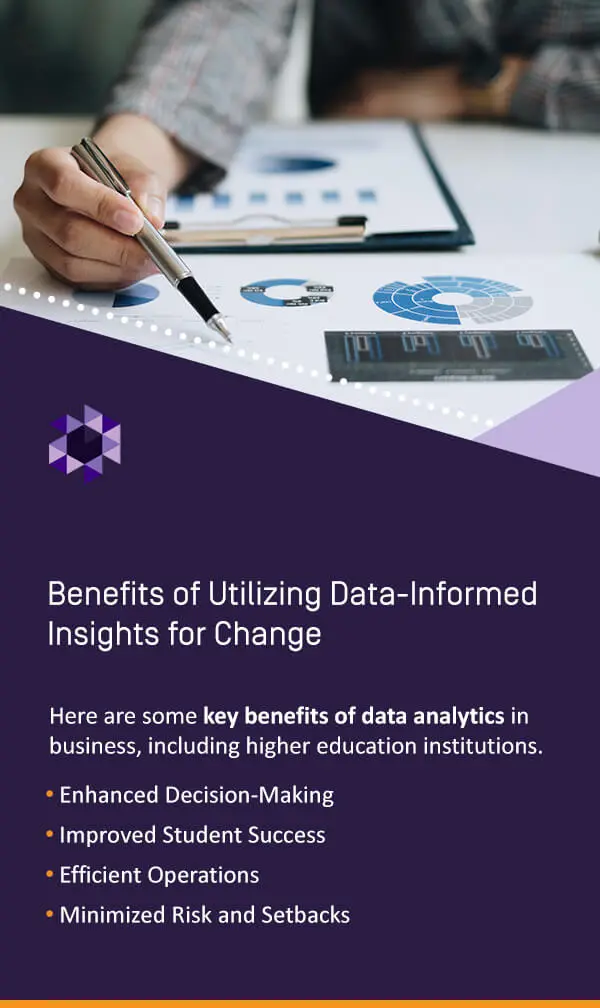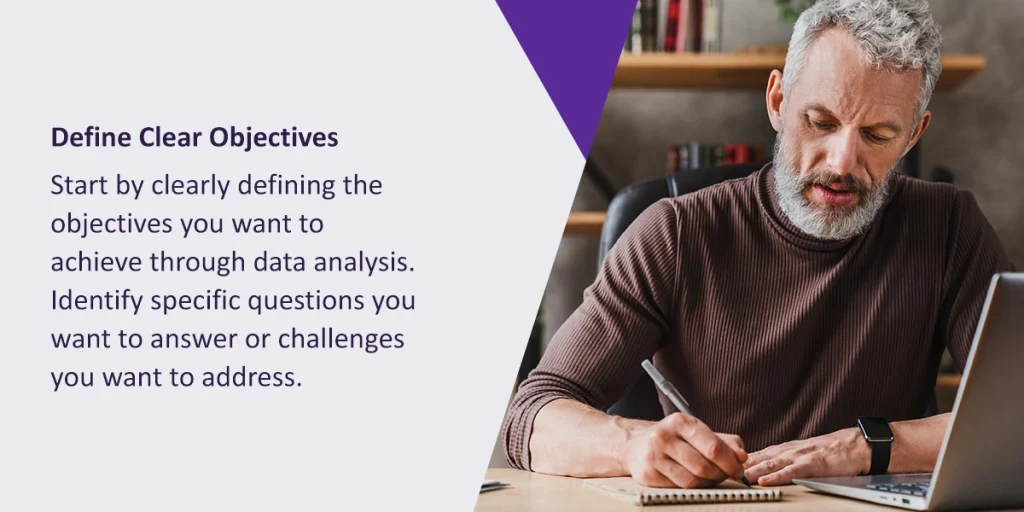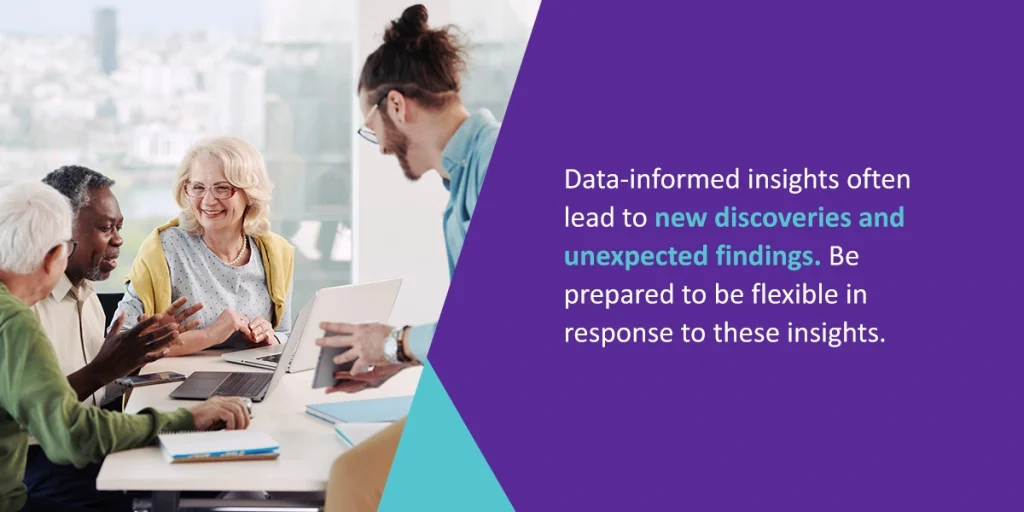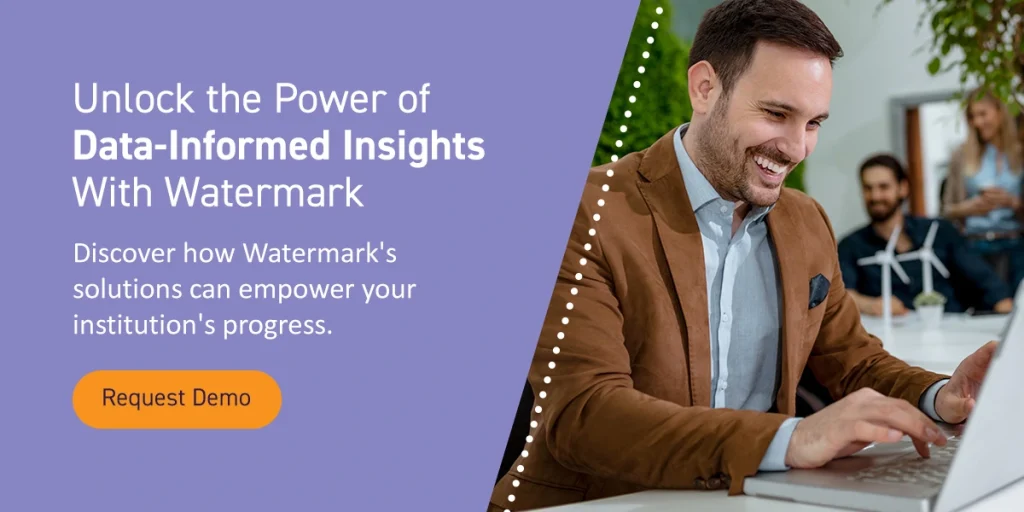



As institutional decision-makers, you understand the challenges of navigating complex educational landscapes and making choices that positively impact your students, faculty, and staff. However, the sheer volume of data available can be overwhelming. That’s where data-informed insights come in — a key driver to success in today’s data-driven world.
This blog will explore the power of applying data-informed insights that can transform your decision-making process. Learn the benefits of applying data-informed insights and uncover practical strategies for implementation that showcase the transformative potential of data.
By harnessing the power of data, you can make informed decisions that have a lasting impact. Here are some key benefits of data analytics in business, including higher education institutions.

Data-informed insights significantly enhance decision-making for higher education institutions. By leveraging data, administrators understand the factors influencing their institution’s performance, allowing them to make well-informed decisions. They can identify trends, patterns, and correlations across various aspects of the institution, such as enrollment, student demographics, faculty performance, and financial indicators. This deeper understanding helps administrators make strategic choices that align with the institution’s goals, improve efficiency, and drive positive outcomes.
Data-informed insights revolutionize student success initiatives within institutions. Administrators can identify at-risk students and personalize interventions by analyzing student data, such as academic performance, engagement, and enrollment and retention rates. They can implement proactive support systems, such as early warning systems and targeted interventions, to address challenges and promote student success. This data-driven approach improves retention rates, fosters academic achievement, and enhances the overall student experience.
Data-informed insights streamline institutional operations by identifying areas for improvement and optimizing processes. Administrators can identify inefficiencies and bottlenecks by analyzing workflow, resource utilization, and administrative tasks. They can then implement changes to streamline operations, automate repetitive tasks, and improve stakeholder communication and collaboration. This enhanced efficiency frees up resources, reduces costs, and enables administrators to focus on strategic initiatives and innovation.
Data-informed insights play a crucial role in risk management and resilience planning. Administrators can identify potential risks, anticipate challenges, and develop contingency plans by analyzing historical and real-time data. Data can highlight patterns that indicate potential setbacks or issues, allowing institutions to take proactive measures to mitigate their impact. This proactive approach enhances the institution’s ability to navigate uncertainties and handle setbacks effectively, minimizing disruptions to operations and maintaining continuity.
Applying data-informed insights in higher education institutions is crucial for making informed decisions, improving student outcomes, and driving institutional success. Here are some practical tips on how to apply data-informed insights.

Start by clearly defining the objectives you want to achieve through data analysis. Identify specific questions you want to answer or challenges you want to address. This clarity will guide your data collection and analysis efforts, ensuring a focused approach aligned with your institution’s goals. For example, you may want to analyze student retention rates to identify factors contributing to student success or investigate enrollment patterns to inform recruitment strategies.
When embarking on your data-informed journey, it’s best to start small and focus on a specific project or area where data can provide valuable insights. By selecting a manageable scope, you can demonstrate quick wins and build momentum for broader adoption. Engage with stakeholders from the beginning to understand their needs and ensure that the insights generated align with the institution’s strategic goals. This collaborative approach ensures we target data analysis efforts and deliver tangible benefits.
Anticipating and addressing potential obstacles is vital for effectively applying data-informed insights. Conduct a thorough assessment to identify any barriers hindering the successful implementation of data-driven initiatives. These obstacles could include resistance to change, data quality issues, or the need for more resources or expertise. By proactively identifying and addressing these challenges, you can develop strategies to overcome them. This may involve providing training and support, establishing data governance practices, or securing necessary resources to ensure the success of your data-informed initiatives.
Define the necessary steps, allocate resources, and establish timelines for each project phase. Clearly communicate the plan to stakeholders to ensure alignment of goals and objectives among everyone. A comprehensive plan helps ensure that all necessary infrastructure, tools, and processes are in place to support the successful application of data-informed insights. Regularly review and update the plan to adapt to changing needs and circumstances.

Data-informed insights often lead to new discoveries and unexpected findings. Be prepared to be flexible in response to these insights. Embrace the notion that new data may challenge existing assumptions and be open to adjusting strategies or approaches based on the insights gained. Flexibility allows you to seize opportunities and make informed decisions that align with the changing landscape of your institution and the evolving needs of students and stakeholders.
Involve stakeholders in the data analysis process, including faculty, staff, students, and community members. Seek their perspectives, input, and feedback to understand the institution’s strengths and areas for improvement. Engaging stakeholders also enhances buy-in and support for data-informed initiatives. Stakeholders can contribute their insights and perspectives through focus groups, surveys, or advisory committees.
Foster a data-driven culture throughout your institution. Promote the importance of data-informed decision-making and provide training and resources to enhance data literacy skills among faculty and staff. Encourage collaboration and discussions around data findings, promoting a culture that values evidence-based practices. Empower stakeholders to understand and effectively use data through workshops, seminars, and data literacy programs.
Close the loop with technology solutions that streamline data collection, analysis, and reporting processes. Utilize data analytics tools, visualization platforms, and learning management systems to analyze and interpret data efficiently. These technologies can automate data processing tasks, provide real-time insights, and facilitate data-driven decision-making. For instance, a learning analytics system can help identify at-risk students, allowing for targeted interventions and support.
By following these tips for closing the loop and applying data-informed insights, college and university administrators can leverage data to inform decision-making, drive positive change, and achieve their institution’s goals. Embrace the transformative power of data-informed insights and unlock the potential for growth and improvement within your institution.
Note that there are a lot of variables when it comes to student learning, which can make measurement and analysis difficult. Even when you have clearly defined your learning outcomes and established what you’re trying to measure, it can be challenging to pinpoint what’s working and what’s not. But with regular review and consistent conversations, you can create a data-informed culture on your campus and make informed decisions that drive real change.
For more tips, watch the assessment foundations for making data-informed decisions webinar.
In closing, applying data-informed insights is a game-changer for higher education decision-makers seeking to drive positive change. By harnessing the transformative potential of data, institutions can make informed decisions, enhance student success, streamline operations, mitigate risks, and plan for the future — and Watermark is here to help you on this journey.
With over 20 years of experience and a comprehensive suite of solutions, Watermark provides higher education institutions with the tools to collect, manage, and measure data effectively. Discover how Watermark’s solutions can empower your institution’s progress.
Request a demo today and unlock the power of data-informed insights with Watermark.






























































































































































































































































































































































































